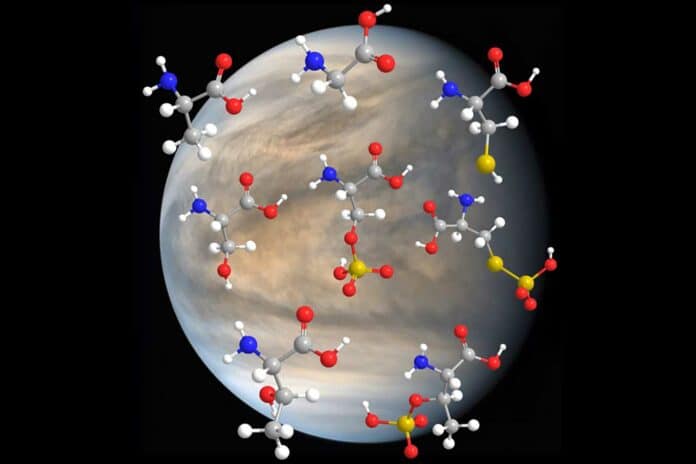Scientists have long been fascinated by the possibility that Venus’s cloud layers, located at elevations of 48–60 kilometers and have temperatures more akin to Earth’s, could be habitable. But it was generally accepted that since concentrated sulfuric acid, an extremely potent solvent unsuitable for supporting life as we know it makes up the clouds, life could not exist there.
The idea that life couldn’t exist in Venus’ cloud layers because of the intense sulfuric acid there is called into question by a recent study conducted by MIT researchers. The study, published in the journal Astrobiology, shows that some of the fundamental components of life may withstand prolonged exposure to strong sulfuric acid solutions.
The researchers revealed that 19 amino acids needed for life on Earth can last up to four weeks when placed in vials of sulfuric acid at quantities equivalent to those found in Venus’ clouds. Surprisingly, these amino acids’ structural structures held up well in sulfuric acid solutions, with concentrations ranging from 81 to 98 percent.
The hypothesis that concentrated sulfuric acid is always detrimental to organic chemistry is called into question by this discovery.
Study author Sara Seager, MIT‘s Class of 1941 Professor of Planetary Sciences in EAPS and a professor in the departments of Physics and Aeronautics and Astronautics, said, “We are finding that building blocks of life on Earth are stable in sulfuric acid, and this is very intriguing for the idea of the possibility of life on Venus. It doesn’t mean that life there will be the same as here. In fact, we know it can’t be. But this work advances the notion that Venus’ clouds could support complex chemicals needed for life.”
To determine what remnants of Earthly life might also be stable in Venus’ clouds—which are thought to be orders of magnitude more acidic than the most acidic locations on Earth—Searger and her colleagues have been testing different molecules in concentrated sulfuric acid before the mission’s launch in January 2025.
Prior studies conducted by the researchers revealed that complex organic compounds such as nucleic acids and fatty acids may maintain their stability in sulfuric acid, suggesting that Venus’ clouds may be habitable.
In their most recent work, the researchers focused on amino acids, the building blocks of necessary proteins. All living things depend on proteins for various processes, including the production of energy, the healing of damaged tissue, and the development of muscle. Thus, knowledge of the behavior of amino acids in sulfuric acid environments offers crucial new information about the possible habitability of Venus’ clouds.
Maxwell Seager, an undergraduate in the Department of Chemistry at Worcester Polytechnic Institute and Seager’s son said, “If you consider the four major building blocks of life as nucleic acid bases, amino acids, fatty acids, and carbohydrates, we have demonstrated that some fatty acids can form micelles and vesicles in sulfuric acid, and the nucleic acid bases are stable in sulfuric acid. Carbohydrates are highly reactive in sulfuric acid. That only left us with amino acids as the last major building block to study.”
The scientists embarked on their investigation of sulfuric acid during the pandemic, conducting experiments in a home laboratory. Following this initial phase, Seager and her son continued their work on chemistry in concentrated sulfuric acid. In early 2023, they acquired powder samples of 20 “biogenic” amino acids — critical for all life on Earth. These amino acids were dissolved in vials of sulfuric acid mixed with water at concentrations ranging from 81 to 98 percent, mirroring the conditions found in Venus’ clouds.
Subsequently, the vials were incubated for a day before being transferred to MIT’s Department of Chemistry Instrumentation Facility (DCIF). This facility offers a range of automated and manual instruments accessible to MIT scientists around the clock. Utilizing the lab’s nuclear magnetic resonance (NMR) spectrometer, Seager’s team analyzed the structure of amino acids in sulfuric acid.
Over four weeks, the scientists repeatedly examined each vial. To their surprise, their findings revealed that the fundamental molecular structure, or “backbone,” of 19 of the 20 amino acids remained stable and unaltered, even under highly acidic conditions.
Maxwell Seager said, “Just showing that this backbone is stable in sulfuric acid doesn’t mean there is life on Venus. But if we had shown that this backbone was compromised, there would be no chance of life as we know it.”
Sanjay Limaye, a planetary scientist at the University of Wisconsin who has studied Venus for over 45 years and who was not involved with this study, said, “Now, with the discovery that many amino acids and nucleic acids are stable in 98 percent sulfuric acid, the possibility of life surviving in sulfuric acid may not be so far-fetched or fantastic. Of course, many obstacles lie ahead, but life that evolved in water and adapted to sulfuric acid may not be easily dismissed.”
The team admits that Venus’ cloud chemistry is probably messier than the “test tube” circumstances used in the study. For example, scientists have measured other trace chemicals in the planet’s clouds in addition to sulfuric acid. As a result, the group intends to include specific trace gases in the next studies.
Journal Reference:
- Maxwell D. Seager, Sara Seager, William Bains, and Janusz J. Petkowski. Habitability of Venus’ Clouds. Astrobiology. DOI: 10.1089/ast.2023.0082
